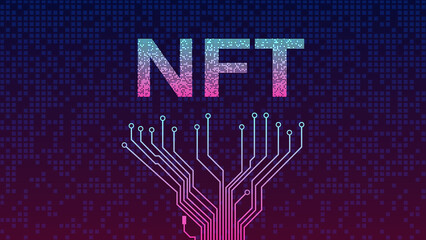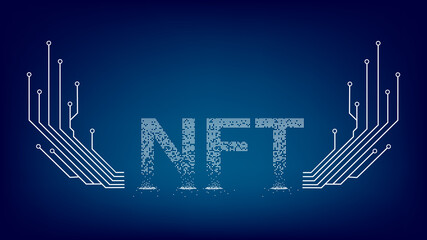In the ever-evolving landscape of digital innovation, Non-Fungible Tokens (NFTs) have emerged as a groundbreaking force, particularly in the realm of digital art. These unique cryptographic assets, built on blockchain technology, have transformed the way artists create, own, and sell their work. NFTs are not just another trendy buzzword; they represent a fundamental shift in how value is attributed to digital creations.
At its core, an NFT is a token that represents ownership of a unique item, whether it’s a piece of art, music, video, or even virtual real estate. Unlike traditional cryptocurrencies like Bitcoin or Ethereum, which are interchangeable (fungible), NFTs are indivisible and irreplaceable. This uniqueness gives them the power to authenticate and prove ownership of digital assets, a problem that has long plagued the art world.
Digital art has always struggled with issues of authenticity and provenance. Without physical tangible forms, it was challenging to verify the originality of a piece or track its ownership history. NFTs solve this problem by recording each transaction on a decentralized blockchain ledger. This transparency ensures that every piece of digital art can be traced back to its creator, providing a sense of rarity and exclusivity that is unparalleled in the digital realm.

One of the most significant impacts of NFTs is the way they have empowered independent artists. In the past, digital artists often faced an uphill battle to monetize their work. Platforms like Instagram or Pinterest allowed them to showcase their creations, but they rarely received fair compensation. The rise of NFT marketplaces like OpenSea and Rarible has changed the game, providing artists with direct access to global audiences and enabling them to sell their work for millions of dollars.
Take, for instance, the case of Beeple, a digital artist whose work fetched over $69 million at a Christie’s auction in 2021. This landmark sale highlighted the growing recognition of digital art as a legitimate form of artistic expression, capable of achieving astronomical valuations. NFTs have not only given artists like Beeple the platform to succeed but also redefined the economics of the art world.
Moreover, NFTs have introduced new forms of creativity and collaboration. Artists are now experimenting with interactive and dynamic art pieces that evolve over time or respond to user input. For example, Damien Hirst’s “TheERC721” project features a series of NFTs that allow owners to modify the artwork by selecting different DNA sequences. This level of interactivity is a far cry from traditional art forms, where the final piece is static and unchangeable.
The role of NFTs in digital art also extends beyond the realm of high-profile artists. It has democratized the art market, allowing even novice creators to showcase and sell their work on a global scale. Young artists who may have struggled to gain recognition in traditional galleries now have a platform that values their creativity purely based on merit and market demand.
However, the rise of NFTs has not been without controversy. Critics argue that the energy consumption of blockchain networks, particularly those using proof-of-work mechanisms like Bitcoin and Ethereum, is environmentally unsustainable. The carbon footprint of NFT transactions has sparked debates about the ethical implications of this emerging technology.
Despite these challenges, the potential of NFTs to transform digital art is undeniable. As blockchain technology continues to evolve, we can expect to see innovative solutions that address environmental concerns while maintaining the integrity and authenticity of NFTs.
In conclusion, the role of NFTs in digital art is multifaceted. They have revolutionized the way artists create, own, and sell their work, democratizing the art market and opening doors for artists who may have otherwise been overlooked. As the world becomes increasingly digital, NFTs serve as a bridge between the physical and virtual realms, redefining what it means to own a piece of art in the 21st century.
The impact of NFTs extends beyond the realm of visual art, finding applications in music, video, and even virtual worlds. This versatility underscores the transformative potential of NFTs in reshaping the digital ecosystem and challenging traditional notions of ownership and creativity.
One of the most exciting developments in the NFT space is its application in virtual reality (VR) and augmented reality (AR). Platforms like Decentraland and The Sandbox have created immersive digital environments where users can buy, sell, and showcase their NFTs. These virtual spaces are not just gaming platforms; they are digital galleries, concert venues, and social hubs, all governed by the underlying principles of blockchain technology.
For example, virtual real estate in Decentraland has become a sought-after commodity, with plots of land selling for hundreds of thousands of dollars. These parcels of digital land are represented as NFTs, giving owners complete control over their appearance and functionality. Owners can build virtual galleries, host events, or even sell advertising space, creating new avenues for monetization in the digital realm.
Another groundbreaking application of NFTs is in the field of music. Musicians are now using NFTs to release exclusive tracks, album artwork, and even tickets for virtual concerts. Unlike traditional music distribution, which often results in artists receiving only a fraction of the revenue, NFTs allow artists to retain full control over their work and receive direct compensation from fans.
The indie music scene has particularly embraced NFTs as a way to bypass traditional gatekeepers like record labels. Artists can now create limited-edition NFTs that include exclusive content, merchandise, or even virtual meet-and-greets, fostering a deeper connection with their audience. For instance,3LAU, a popular electronic music producer, sold $11.6 million worth of NFTs in a single auction, demonstrating the vast potential of NFTs in the music industry.
NFTs have also opened up new opportunities for storytelling and narrative-driven art. With the rise of interactive and dynamic NFTs, artists can create immersive experiences that engage viewers on a deeper level. For example, the blockchain-based game “Axie Infinity” allows players to collect and trade NFTs representing creatures, land, and other in-game items. These NFTs are not just tools for gameplay; they are works of art that tell a story and belong to the players who own them.
The future of NFTs in digital art is poised to be even more exciting, with advancements in technology paving the way for new possibilities. The concept of “fractional ownership,” where multiple people can own a share of an NFT, is gaining traction. This model could make high-value NFTs more accessible to a broader audience while still honoring the original creator’s rights.
Additionally, the integration of artificial intelligence (AI) with NFTs is opening up new frontiers for creativity. AI-generated art, such as pieces created by algorithms trained on vast datasets of existing works, is being tokenized as NFTs. This raises interesting questions about authorship and value, as machines increasingly play a role in the creative process.
Despite these advancements, the NFT ecosystem is still in its infancy, and challenges remain. Regulatory frameworks are lagging behind the rapid pace of technological innovation, leaving artists and collectors exposed to legal uncertainties. Furthermore, the speculative nature of the NFT market has led to volatility, with prices swinging wildly based on market sentiment.
However, these challenges are not insurmountable. As the technology matures and adoption grows, we can expect to see more robust regulatory structures and greater market stability. The key to NFTs’ long-term success lies in their ability to deliver real value to artists, collectors, and the broader digital ecosystem.
In conclusion, the role of NFTs in digital art is not just about selling art; it’s about redefining what art can be and how it interacts with the world. From immersive virtual environments to AI-driven creations, NFTs are pushing the boundaries of creativity and ownership. As the digital landscape continues to evolve, NFTs will undoubtedly play a central role in shaping the future of art, offering endless possibilities for innovation and expression.
